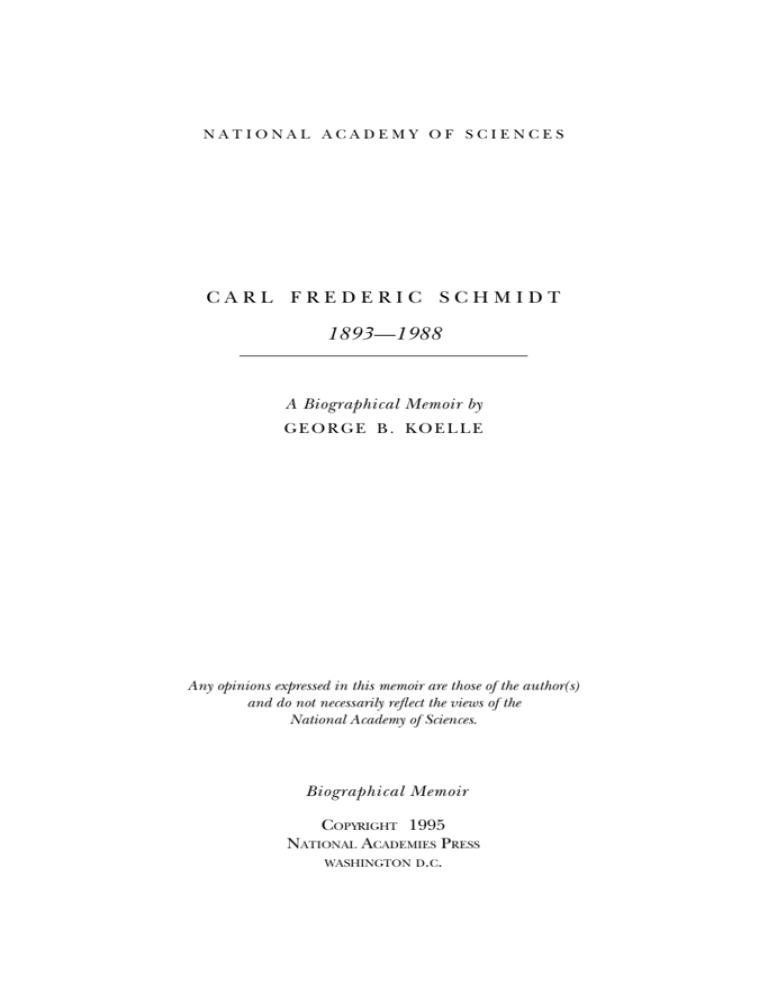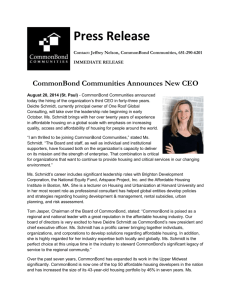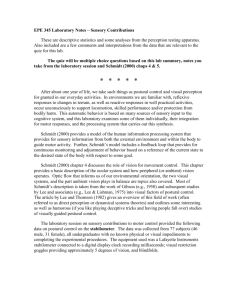carl frederic schmidt - National Academy of Sciences
advertisement

national academy of sciences Carl Frederic Schmidt 1893—1988 A Biographical Memoir by George B. Koelle Any opinions expressed in this memoir are those of the author(s) and do not necessarily reflect the views of the National Academy of Sciences. Biographical Memoir Copyright 1995 National Academies Press washington d.c. CARL FREDERIC SCHMIDT July 29, 1893–April 4, 1988 BY GEORGE B. KOELLE C ARL FREDERIC SCHMIDT was born on July 29, 1893, in Lebanon, Pa. Less than fifty years earlier, Rudolf Bucheim (1820-79) set up in Dorpat, Estonia, the world’s first laborator y devoted to the study of the actions of drugs. Bucheim’s successor, Oswald Schmiedeberg (1838-1921), subsequently moved to Strassburg where he eventually became universally regarded as the father of pharmacology; in all, he helped to train approximately 120 students from twenty or so countries. Thus, the birth of Carl F. Schmidt and that of the science of pharmacology were nearly synchronous. Carl Schmidt’s paternal grandfather, Jacob, came to the United States from Germany in 1870 for the same reason as mine: to avoid the Kaiser’s draft. He settled in Philadelphia, where his dual trades were violinist and repairer of pipe organs. His son, Jacob Carl, was apprenticed to a jeweler in Reading, Pa. The son was approximately six and half feet tall, weighed 300 pounds, and was quite an athlete; he pitched for a short time for the Baltimore Orioles, and for several years thereafter was a “scorcher,” or demon rider of penny-farthing bicycles. After establishing his own jewelry store in Reading, where Jacob met his wife, Ella Greth of Scotch-Irish ancestry, the family and business moved to Lebanon, Pa., where Carl was born. 273 274 BIOGRAPHICAL MEMOIRS Carl enjoyed the standard boyhood offered by a small town at the turn of the century. He and his elder brother, Edward, were active in the usual sports, particularly baseball, football, bicycling, fishing, and hiking. He recalled that at one time they constructed a crystal set radio receiver, but they never learned whether it functioned because there was no broadcasting station in the vicinity. Throughout high school Carl received good grades and finished first in his class. He was then faced with the decision of what career to choose. He decided against taking up his father’s trade as a jeweler as well as that of an automobile mechanic at which he had dabbled for several years. Two more plausible choices remained: he was offered a two-year scholarship at Lebanon Valley College, on the basis of his high school grades, and an appointment to West Point. He opted for the latter, but failed the physical examination (because of his limited chest expansion); therefore, he accepted the college scholarship. This was subsequently renewed. Halfway through college he met Elizabeth (Betsy) Viola Gruber, the middle member of a family of seven sisters plus one brother. They went steady for six years, then became engaged, and eventually, when Carl completed his internship, were married. They enjoyed an ideal marriage for sixty-two years until the death of Mrs. Schmidt. I remember her as a lovely person. Just before Carl’s graduation from college, the Schmidt family physician was elected state senator, which permitted him to offer Carl a scholarship to any school at the University of Pennsylvania. He accepted with alacrity and chose the medical school because of its outstanding reputation. He remained there most of the time from then on as a student, intern, faculty member, department chairman, and professor emeritus until his death at the age of ninety-four. During his preclinical two years at Penn, Schmidt was CARL FREDERIC SCHMIDT 275 particularly impressed by the courses of Allen J. Smith in pathology and Alfred Newton Richards in pharmacology. The latter was the youngest chairman, having arrived at Penn jut half a dozen years earlier in 1910. Carl graduated in 1918, at the top of his class. He received a commission in the Army Medical Corps and entered a rotating internship at the Hospital of the University of Pennsylvania (HUP). There, his first assignment was to complete the blood counts of members of a crew of British and Indian seamen from a ship that had put out from Bombay a month earlier, had been refused landing at Liverpool because of an undiagnosed illness aboard, and had gone on to Philadelphia. They were found to be suffering from a vague but deadly type of respirator y infection and were wisely held in a quarantined ward at HUP. These patients proved to be the first seen in the United States in the threewave great influenza pandemic. Before it had run its course it was responsible for several million deaths. In Philadelphia, it was the greatest medical crisis since the yellow fever epidemic of 1793. The disease was found eventually to be caused by a virus (at the time, these were only theoretical entities) with a secondary streptococcal pulmonary infection; no treatment other than palliative was available. The course of the pandemic extended well beyond the armistice of World War I on November 11, 1918. Consequently, Carl Schmidt’s internship was a grim, exhaustive experience. When it ended, in August 1919, Carl considered a number of possibilities and settled for the offer of an instructorship in pharmacology from Alfred Newton Richards. He never regretted the decision. With Carl’s addition to the department, the faculty now numbered three, the other member being Oscar Plant who was an active participant in Richards’s early memorable studies of glomerular filtration. In addition to his teaching duties, 276 BIOGRAPHICAL MEMOIRS which he entered with enthusiasm, Schmidt initiated his own research program in collaboration with W. Benson Harrer (1923), which focused on the interrelationships between carbon dioxide, and morphine, heroin, and several other drugs, in their modification of respiration of the dog. For a short time Carl participated with Richards in the latter’s renal program and succeeded in developing a method for visualizing the circulation of the kidney by means of a coverslip and overhead illumination (1924,1). However, these microscopic studies proved harmful to his eyes and he abandoned them. While casting about to decide on his next research program, an opportunity presented itself that, after some deliberation, he and Mrs. Schmidt seized upon with enthusiasm. Through Richards, he was invited to spend two years teaching at the Peking Union Medical College with the support of the Rockefeller Foundation. Early in the summer of 1922 the Schmidts set out to China by way of Vancouver, the Great Circle route near the Aleutian Islands, Yokohama, Tokyo, Kobe, Nagasaki, and Shanghai, and from there by an exhausting train trip to Peking, or as it is now called, Beijing. They were surprised and delighted by the spectacle of the medical college itself and of the comfortable cottage on the grounds which they were to occupy for the next two years. During that time the two outstanding events that occurred in their lives were the birth of Carl F. Schmidt, Jr., on June 16, 1923, and the discovery or rediscovery along with K. K. Chen, of the sympathomimetic alkaloid ephedrine (discussed below). It is notable that a remarkable number of outstanding American medical educators and investigators spent varying periods at Peking Union Medical College during those years.1 In spite of the many changes in government, the medical school still functions as such; my wife Win and I visited Schmidt’s old laborator y there ten years ago and were de- CARL FREDERIC SCHMIDT 277 lighted to see the medical students still conducting pharmacological exercises. While a number of battles were occurring during the early twenties among the major warlords, particularly in Manchuria to the north, fortunately for the Schmidts Peking did not become involved until after they left. Following the Schmidts’ return to Philadelphia in 1924, Carl resumed his former post at Penn as assistant professor of pharmacology, then associate professor (1929), professor (1931), chairman (1939), and professor emeritus (195988). In 1927 their daughter Barbara Elizabeth (deLong) was born. Just before and after his retirement from the University of Pennsylvania, Carl ser ved as the editor of Circulation Research (1958-62), and was then appointed research director of the Naval Air Developmental Center at Johnsville, Pa. (1962-69), from which he finally retired at age seventyfive. He and Mrs. Schmidt moved temporarily to Florida, where he ser ved as clinical professor of pharmacology at the University of South Florida College of Medicine in Tampa (1970-82). His research, additional activities, and honors are related in the sections that follow. RESEARCH Fortunately for the writer, Schmidt separated his publications into appropriate categories; here, the sequence and titles are modified slightly to allow a more chronological presentation. CHINESE DRUGS When Carl Schmidt embarked on his Chinese adventure, it had been suggested that he investigate the drugs in the Chinese pharmacopoeia to find any that might be of particular value. There were approximately 4,000. As a basis for starting this awesome project, he and his young Chinese 278 BIOGRAPHICAL MEMOIRS colleague, K. K. Chen, selected the drugs, mostly of botanical origin, that were prescribed most frequently. (This was long before the advent of the computer, which would have simplified the task somewhat.) The results obtained with the first half-dozen drugs that were tested were discouraging. Then Chen discussed the project with his uncle, a Chinese pharmacist. The latter suggested that they investigate ma huang, a plant that had been tasted by the Emperor Shen Nung more than 5,000 years earlier and placed in the “medium class.” Chen prepared an aqueous extract of the crude drug which was injected into a dog at the conclusion of a student practice experiment. To their amazement it produced a prolonged rise in blood pressure (all other botanical extracts produced only hypotension or nothing.) Within a few days Chen isolated the active principle; a search of the literature revealed that it had been found nearly fifty years earlier by the Japanese investigator N. Nagai and named ephedrine. However, only a few short notes had been published on its actions. Chen and Schmidt conducted a thorough investigation of ephedrine, which showed it to be an orally active, long-acting sympathomimetic amine of a structure somewhat similar to that of epinephrine (1924,2). As a result, ephedrine and similar synthetic compounds were introduced into Western medicine and became widely employed for their cardiovascular, bronchodilator, and other actions (1930). RESPIRATORY AND CIRCULATORY REFLEXES After his return from China, along with excursions into other areas, Schmidt’s major investigative work was divided between studies of respiratory and circulatory reflexes and the cerebral circulation. In 1867 von Bezold and Hirt2 reported that the injection of veratrine in rabbits caused bradycardia, hypotension, and CARL FREDERIC SCHMIDT 279 apnea. This obser vation was practically overlooked until it was rediscovered by Jarisch in 1940,3 when it was named the Bezold-Jarisch reflex. Further investigation of this phenomenon by Corneille F. Heymans of Ghent and his collaborators4 led to the discovery of both chemoreceptors and pressoreceptors in the region of the internal carotid artery that produced marked reflexes in the respirator y and circulatory systems. Carl Schmidt and his colleagues became involved in the same field. The latter group included principally Julius H. Comroe, Jr., and Domingo M. Aviado, Jr., as well as Aurilio Cerletti, Robert D. Dripps, Jr., Paul R. Dumke, Marilyn E. Hess, Orville Horwitz, Werner Kalow, T. H. Li, and others. The laboratories of Heymans and Schmidt became the preeminent ones in the world for their work in unraveling these complicated systems. To summarize this research, it was shown that nicotine and other drugs also elicit the same reflexes. They were found to arise from one or both types of receptor not only in the carotid area but from the aortic body (the equivalent of the chemoreceptors of the carotid body) and aortic arch (which resembles the pressoreceptors of the carotid sinus), as well as from the upper respiratory tract, pulmonary venous area, coronary arter y, and cardiac muscle and surface. Much of the early work was reviewed by Schmidt (1945,1) and by Aviado and Schmidt (1955); it has recently been updated by Aviado.5 These studies represented not only a major contribution to basic physiology, but were of great importance in the work of Schmidt and his colleagues (1943,1) in aviation medicine during World War II and in Schmidt and Lambertsen’s (1965) later involvement in the physiological aspects of space travel as discussed below. 280 BIOGRAPHICAL MEMOIRS CEREBRAL BLOOD FLOW Carl Schmidt’s interest in the control of respiration directed him to studies of the influence of cerebral blood flow on respiration (1923, 1928), in which measurement of the perfusion function was initially based on venous outflow, giving way eventually to the use of a cooled or heated thermocouple (1934). In 1943, with Paul Dumke, he made the first quantitative and reliable measurements of cerebral blood flow in the macaque monkey by intercalating into the arterial input a bubble flow meter (1943,2). Two years later he extended his measurements to cerebral oxygen consumption under a variety of experimental conditions (1945,2). While participating in those studies, Seymour Kety, who had joined the laboratory in 1943, devised a technique for measuring the blood flow through the human brain, utilizing the exchange of an inert gas between the perfusing blood and the brain. With Carl Schmidt he tested the technique in the monkey and calibrated it against the bubble flow meter (1945,3). The Kety-Schmidt technique was applied in 1948 to normal volunteers for the first measurements of blood flow and energy metabolism in the human brain (1948,7) and then to a number of physiological and pathological states (1948,2-5). RENAL CIRCULATION In addition to his early work with A. N. Richards, cited above, Carl Schmidt subsequently investigated the renal circulation in collaboration with J. M. Hayman, Jr. (1929), Arthur M. Walker (1937), and John H. Moyer, Hadley Conn, and others (1950). MISCELLANEOUS In collaboration with Alfred E. Livingston, Schmidt published a number of studies on the actions of morphine and CARL FREDERIC SCHMIDT 281 related drugs (1933). He and Harry D. Bruner (1947) studied the bloodflow in the bronchial artery. With Christian J. Lambertsen, P. L. Bunce, and David L. Drabkin (1952) he measured the relationship between oxygen tension and hemoglobin oxygen saturation. Although I was Schmidt’s first graduate student, I never had the privilege of working in his laboratory. He graciously allowed me to submit some work I had completed during World War II in collaboration with Alfred Gilman at the Medical Research Laboratory, Edgewood Arsenal, as a thesis. AVIATION AND SPACE MEDICINE With the advent of World War II, Schmidt became deeply involved in aviation medicine. Here his aim was the development of means for improving the performance of pilots under extremes of gravitational and anoxic stresses (1943). He returned to the same area many years later at another level, after he became research director of the Naval Air Development Center, which contained the world’s largest human centrifuge. He worked closely with John Glenn, Scott Carpenter, Wally Schirra, L. Gordon Cooper, Virgil Grissom, Frank Borman, Neil Armstrong, and the other pioneer astronauts in showing them how to deal with the tremendous G-forces they would encounter (1965). HONORS AND MEMBERSHIPS The list of Schmidt’s societies and offices, editorships, committees, lectureships, and honors is a long one. Pharmacology on the international scene began as the Section on Pharmacology (SEPHAR) of the International Union of Physiological Sciences (IUPS), which in turn belonged to the International Council of Scientific Unions (ICSU). (At the annual meetings of the American Pharmacological So- 282 BIOGRAPHICAL MEMOIRS ciety, Schmidt used to delight us all with accounts of the activities of these acronymical associations.) Among all the pharmacologists of the world, Schmidt was elected the first president of SEPHAR, in 1959. When pharmacology achieved independent status in 1965 as IUPHAR—the reader can work out that one—Schmidt, by then retired, was elected its honorary president. Schmidt belonged to the American Society for Pharmacology and Experimental Therapeutics (vice-president, 194042; president, 1948-50). He was also a member of the National Academy of Sciences (elected 1949); the American Academy of Arts and Sciences; American Heart Association; American Physiological Society; Society for Experimental Biology and Medicine; Association of American Physicians; American Association for the Advancement of Science (fellow); Physiological Society of Philadelphia; College of Physicians of Philadelphia (fellow); Penn Valley Association (president, 1944-46); Medical Association of the Argentine; Merion Cricket Club; and others. Schmidt was managing editor of the Journal of Pharmacology and Experimental Therapeutics (194042) and Circulation Research (1958-62) and associate editor of Chemical Abstracts (1942-48). The list of his memberships on important international and national committees is extensive. Among Carl Schmidt’s many honors were honorar y degrees from his alma maters, Lebanon Valley College and the University of Pennsylvania, and from Charles University in Prague. In 1984 he received the Distinguished Graduate Award of the School of Medicine of the University of Pennsylvania. In 1962 he was the sixth recipient over many years of the Schmiedeberg Plakette of the German Pharmacological Society. The citation that accompanied the award captured the man: “for magnificent contributions to ser- CARL FREDERIC SCHMIDT 283 vice for pharmacology and in recognition of his spirit of magnanimity and great humanity.” GENERAL The designation “clinical pharmacology” refers to a relatively young branch of the science that concerns the investigation of new drugs in human subjects after their efficacy and safety have been established by animal studies. Although I never heard either of them use the term, Schmidt and his predecessor Richards (1971) were among the pioneers in this field. Most of their junior associates were residents in internal medicine, anesthesiology, and other medical specialties who spent one or more years in the Department of Pharmacology learning the principles of pharmacological research. They then returned to their clinical departments to put these principles into practice. In addition to their extended stay in China early in Carl Schmidt’s career, the Schmidts did considerable traveling for his participation in international meetings, lecturing, and service with the Unitarian Medical Mission to Germany in 1948. Their most extensive journeys were taken shortly before his retirement from Penn; between July 1955 and February 1956, they took four trips covering some 50,000 miles. On those occasions their destinations included the Philippines, Japan, Taiwan, Hong Kong, Australia, New Zealand, Indonesia, Singapore, Thailand, Vietnam, Burma, India, Pakistan, Sudan, Rhodesia, Uganda, Kenya, Lebanon, Syria, Israel, Jordan, Egypt, Madagascar, Turkey, Italy, Spain, France, Greece, and Monaco. In spite of his numerous other activities related above, Schmidt always considered his primary responsibility to be teaching. His lectures were models of clarity, precision, and enthusiasm, and inspired his younger colleagues to follow 284 BIOGRAPHICAL MEMOIRS suit. As a result, pharmacology was generally acknowledged by the students to be the best course in the medical school. In 1976 his old department established the Carl F. Schmidt Honorary Lectureship. Schmidt gave the first annual lecture of the series. Subsequent lectures, which are followed by dinner and an evening of good fellowship, were presented by his former associates and by distinguished pharmacologists from throughout the world. He and Mrs. Schmidt attended all up to the time of their deaths. The Schmidt lectures will continue in perpetuity. After the death of Mrs. Schmidt in 1982, Carl Schmidt lived with his son, Carl, Jr., and his wife Betty. Shortly after Schmidt’s death, at the age of ninety-four, the tragic premature death of his son followed. Betty ministered to them both, with deep affection and devoted care to the end. In addition to his daughter, Barbara Elizabeth deLong, Schmidt left five grandchildren and two great-grandchildren. to Mrs. Carl F. (Betty) Schmidt, Jr., for her time and expertise in assembling the considerable volume of her father-in-law’s unpublished writings and correspondence, upon which most of this memoir is based. Portions of this memoir are reproduced from a shorter one published by the author in the Transactions of the College of Physicians of Philadelphia (ser. 5, vol. 11, no. 3, pp. 261-65, 1989), for which permission has been granted. Mrs. Ava M. Evans typed the manuscript. I AM ESPECIALLY GRATEFUL NOTES 1. J. Z. Bowers. The founding of Peking Union Medical College. Policies and personalities. Bulletin of the History of Medicine 45(1971):30521, 409-29. 2. A. von Bezold and L. Hirt. Über die physiologischen Wirkungen des essigsauren Veratrine. Unters. Physiol. Lab. Wurzburg 1(1867):73122. 3. A. Jarisch. Vom Herzen ausgehende Kreislaufreflexe. Arch. Kreisl.Forsch 7(1940):260-74. CARL FREDERIC SCHMIDT 285 4. C. F. Heymans, and E. Neil. Reflexogenic Areas of the Cardiovascular System. Boston: Little, Brown, 1958. 5. D. M. Aviado. Nicotinic receptors in healthy and ischemic heart with special reference to the Bezold-Jarisch reflex. Arch. Int. Pharmacodyn. 319(1992):5-23. 286 BIOGRAPHICAL MEMOIRS SELECTED BIBLIOGRAPHY 1923 With W. B. Harrer. The action of drugs on respiration. I. The morphine series. J. Exp. Med. 37:47-67. 1924 With A. N. Richards. A description of the glomerular circulation in the frogs kidney and observations concerning the action of adrenalin and various other substances upon it. Am. J. Physiol. 71:178-208. With K. K. Chen. The action of ephedrine, the active principle of the Chinese drug, Ma Huang. J. Pharmacol. Exp. Ther. 24:339-57. 1928 The influence of cerebral blood flow on respiration. I. The respiratory responses to changes in cerebral blood flow. Am. J. Physiol. 84:202-22. 1929 With J. M. Hayman, Jr. A note upon lymph formation in the dog’s kidney and the effect of certain diuretics upon it. Am. J. Physiol. 91:157-60. 1930 With K. K. Chen. Ephedrine and related substances. Medicine 9:2117. 1933 With A. E. Livingston. The relation of dosage to the development of tolerance to morphine in dogs. J. Pharmacol. Exp. Ther. 47:44371. 1934 With J. C. Pierson. The intrinsic regulation of the blood vessels of the medulla oblongata. Am. J. Physiol. 108:241-63. 1937 With A. M. Walker, K. A. Elsom, and C. G. Johnson. Renal blood CARL FREDERIC SCHMIDT 287 flow of unanesthetized rabbits and dogs in diuresis and antidiuresis. Am. J. Physiol. 118:95-110. 1943 Some physiological problems of aviation. Tr. Stud. Coll. Phys. Phila. 11:57-64. With P. R. Dumke. Quantitative measurements of cerebral blood flow in the macaque monkey. Am. J. Physiol. 138:421-31. 1945 Respiration. Ann. Rev. Physiol. 7:231-74. With S. S. Kety and H. H. Pennes. The gaseous metabolism of the brain of the monkey. Am. J. Physiol. 143:33-52. With S. S. Kety. The determination of cerebral blood flow in man by the use of nitrous oxide in low concentrations. Am. J. Physiol. 143:53-66. 1947 With H. D. Bruner. Blood flow in the bronchial artery of the anesthetized dog. Am. J. Physiol. 148:648-66. 1948 With S. S. Kety. The nitrous oxide method for the quantitative determination of cerebral blood flow in man: Theory, procedure and normal values. J. Clin. Invest. 27:476-83. With S. S. Kety, R. B. Woodford, M. H. Harmel, F. A. Frehan, and K. E. Appel. Cerebral blood flow and metabolism in schizophrenia. The effects of barbiturate semi-narcosis, insulin coma and electroshock. Am. J. Psychiat. 104:765-70. With S. S. Kety. The effects of altered arterial tensions of carbon dioxide and oxygen on cerebral blood flow and cerebral oxygen consumption of normal young men. J. Clin. Invest. 27:484-92. With S. S. Kety and H. A. Shenkin. The effects of increased intracranial pressure on cerebral circulatory functions in man. J. Clin. Invest. 27:493-99. With S. S. Kety, B. D. Polis and C. S. Nadler. The blood flow and oxygen consumption of the human brain in diabetic acidosis and coma. J. Clin. Invest. 27:500-510. 288 BIOGRAPHICAL MEMOIRS 1950 With J. H. Moyer, H. Conn, and K. Markley. Attempt to demonstrate vascular by-passes in the kidney (the Trueta phenomenon). Am. J. Physiol. 161:250-58. 1952 With C. J. Lambertsen, P. L. Bunce, and D. L. Drabkin. Relationship of oxygen tension to hemoglobin oxygen saturation in the arterial blood of normal men. J. Appl. Physiol. 4:873-85. 1955 With D. M. Aviado, Jr. Reflexes from stretch receptors in blood vessels, heart and lungs. Physiol. Rev. 35:247-300. 1965 With C. J. Lambertsen. Pharmacology in space medicine. Ann. Rev. Pharmacol. 5:383-404. 1971 Alfred Newton Richards. In Biographical Memoirs, vol. 42, pp. 271318. Washington, D.C.: National Academy Press. CARL FREDERIC SCHMIDT 289








